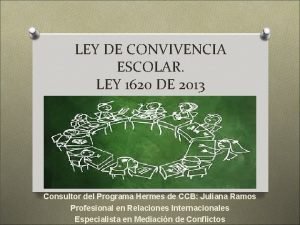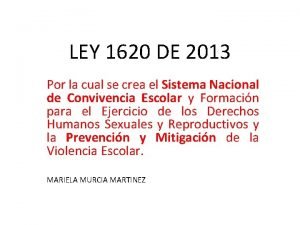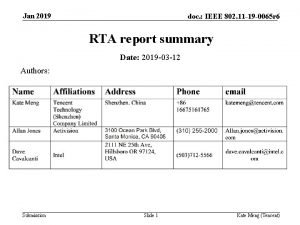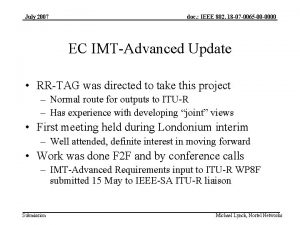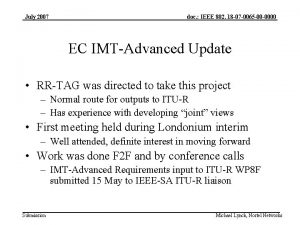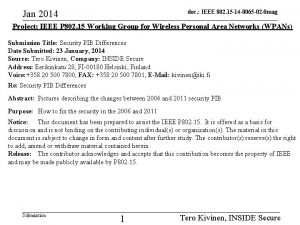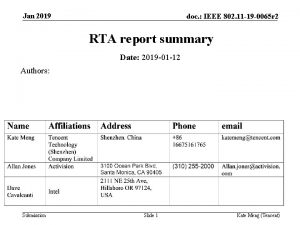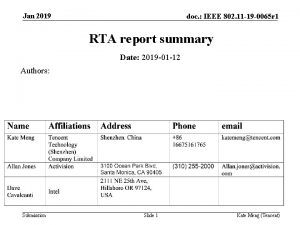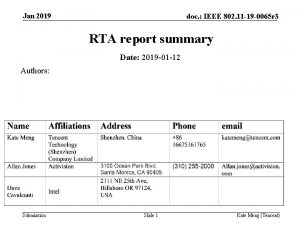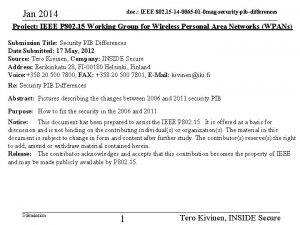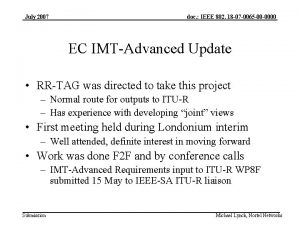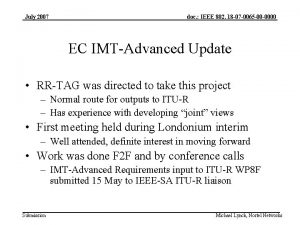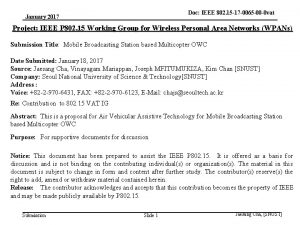January 2013 doc IEEE 802 15 13 0065












- Slides: 12

<January 2013> doc. : IEEE 802. 15 -13 -0065 -03 -0008 Project: IEEE P 802. 15 Working Group for Wireless Personal Area Networks (WPANs) Submission Title: [Issues of System Level Simulation] Date Submitted: [16 January 2013] Source: [Seung-Hoon Park, Sungjin Lee, Sangkyu Baek, Yongbin Chang, Daegyun Kim and Won-il Roh]1, [Marco Hernandez]2, [Sungrae Cho]3 Company [Samsung Electronics]1, [NICT]2, [Chung-Ang University]3 Address [416, Maetan-3 Dong, Yeongtong-Gu, Suwon-Si, Gyeonggi-Do, 443 -742, Korea]1 Voice: [+82 -10 -9349 -9845]1, FAX: [+82 -31 -279 -0813]1, E-Mail: [shannon. park@samsung. com]1 Re: [. ] Abstract: [Issues and proposed compromised scenario & parameters for system-level simulation] Purpose: [To discuss system-level simulation scenario and drive to good texts for TGD] Notice: This document has been prepared to assist the IEEE P 802. 15. It is offered as a basis for discussion and is not binding on the contributing individual(s) or organization(s). The material in this document is subject to change in form and content after further study. The contributor(s) reserve(s) the right to add, amend or withdraw material contained herein. Release: The contributor acknowledges and accepts that this contribution becomes the property of IEEE and may be made publicly available by P 802. 15. Submission Slide 1 <Seung-Hoon Park et. al. >, <Samsung Electronics>

<January 2013> doc. : IEEE 802. 15 -13 -0065 -03 -0008 Issues of System Level Simulation January 16, 2013 Samsung Submission Slide 2 <Seung-Hoon Park et. al. >, <Samsung Electronics>

<January 2013> doc. : IEEE 802. 15 -13 -0065 -03 -0008 Simulation condition (Common) § Simulation condition (Common) Long-term fading Short-term fading Channel bandwidth Maximum TX. power Tx/Rx antenna gain Rx noise figure Receiver sensitivity Submission - Pathloss: the value depends on center frequency (refer to DCN 12 -459 -3 TG 8 channel model document). Propagation between terminals located below roof-top height at UHF from ITU-R P-1411 -6 for 300 MHZ-3000 MHz (mandatory) (refer to DCN 13 -0075 -00). Other pathloss model can be added up to proposers. Not considered. [TBD] MHz (to calculate noise value e. g. -174 d. Bm/Hz x bandwidth) 20 d. Bm -2. 5 d. B 7 d. B -76 d. Bm (for channel sensing) Slide 3 <Seung-Hoon Park et. al. >, <Samsung Electronics>

<January 2013> doc. : IEEE 802. 15 -13 -0065 -03 -0008 Scenarios & parameters for just PDs (Discovery) § Simulation condition PD deployment Simulation time Iteration PHY Abstraction Discovery ID length Discovery transmission interval Submission - Uniform drop in 500 x 500 m 2 area • The number of PDs : 100, 500, 1000, 5000, 10000 over 10 sec over 1000 rounds BPSK, 1/2 coding rate • Common PHY mode is referred to DCN 13 -0058 • Additional PHY mode is up to proposers 16 bytes It depends on proposers. Slide 4 <Seung-Hoon Park et. al. >, <Samsung Electronics>

<January 2013> doc. : IEEE 802. 15 -13 -0065 -03 -0008 Scenarios & parameters for just PDs (Discovery) § Performance metric – Average number of discovered PDs for the simulation time – CDF of the discovery latency according to the number of PDs – Average power consumption [m. W/s] • [comment] we needs power consumption value for TX, RX, IDLE state. Submission Slide 5 <Seung-Hoon Park et. al. >, <Samsung Electronics>

<January 2013> doc. : IEEE 802. 15 -13 -0065 -03 -0008 Issues of Traffic Model for Communication Simulation § Full buffer – Simple, but latency measurement is not natural § Periodic arrival – Simple & latency can be assessed easily – Like voice traffic – Full buffer case can be simulated by setting short period § Statistical model – Interrupted Poisson process, or interrupted discrete process, or interrupted renewal process – More realistic model for burst traffic with more simulation burden – Needs long time for simulation • Due to statistically generated inter-arrival time Submission Slide 6 <Seung-Hoon Park et. al. >, <Samsung Electronics>

<January 2013> doc. : IEEE 802. 15 -13 -0065 -03 -0008 Issues of Connectivity Model for Communication Simulation § UDG (unit disk graph): – Assuming 10% of nodes pairing links (Tx and Rx), according to a transmission range including at most 2 hops. § Link class-based model – At first Tx is deployed uniform randomly – Peered Rx of the Tx is deployed under a specific distance from Tx with the probability of link class selection as follows: (for 1 -hop case) • • • 5 m link distance (a%) (e. g. for connectivity) 10 m link distance (b%) (e. g. for gaming) 20 m link distance (c%) (e. g. for SNS) 40 m link distance (d%) (e. g. for advertising) 80 m link distance (e%) (e. g. public safety) – This model can be extended to multi-hop by repeating deployment Submission Slide 7 <Seung-Hoon Park et. al. >, <Samsung Electronics>

<January 2013> doc. : IEEE 802. 15 -13 -0065 -03 -0008 Scenarios & parameters for PD links (Comm. ) § For communication phase – Including unicast, multicast, broadcast, groupcast, or multi-hop. – Only unicast with 1 hop is mandatory link type § Simulation condition PD deployment Traffic Simulation time Iteration PHY Abstraction Packet (MPDU) length Submission Link class-based model Poisson - Inter arrival time : mean 100 msec at least 10 sec until getting smooth curve Perfect rate adaptation with target PER 0. 1 • Common PHY mode is referred to DCN 13 -0058 • Additional PHY mode is up to proposers • 256 bytes (for low data rate) • 1024 bytes (for high data rate) Slide 8 <Seung-Hoon Park et. al. >, <Samsung Electronics>

<January 2013> doc. : IEEE 802. 15 -13 -0065 -03 -0008 9. 5. Simulation scenarios & parameters (MAC) § Scenarios & parameters for PD links (Comm. ) – Performance metric (y-axis) • Areal sum goodput* [bps/km 2] – In packets, the average amount of received packets in, say 100 rounds, per node • Data packet reception efficiency [ratio] – The index for data throughput, the data packets successfully received to total data packets transmitted ratio. – [1 – the total number of successfully received packet to the total number of transmitted packet] including retransmission procedure • Jain’s fairness index • Latency [sec] – Time until success per message, is the average time a node needs to transmit successfully a complete message. *Goodput is the number of bits in the payload delivered by the network to a certain destination per unit of time. Submission Slide 9 <Seung-Hoon Park et. al. >, <Samsung Electronics>

<January 2013> doc. : IEEE 802. 15 -13 -0065 -03 -0008 Suggestion of Test Scenario for Communication § Density analysis (mandatory) – The number of links is increasing as • 1, 2, 4, …, up to 512 § Packet(MPDU) length analysis (optional) – Packet length is increasing as • 256, 512, 1024, …, up to 4096 bytes § Packet(MPDU) arrival analysis (optional) – Mean of inter arrival time is increasing as • 100, 200, 400, … up to 800 msec Submission Slide 10 <Seung-Hoon Park et. al. >, <Samsung Electronics>

<January 2013> doc. : IEEE 802. 15 -13 -0065 -03 -0008 9. 5. Simulation scenarios & parameters (MAC) § Proposed reference system (optional) – For calibration and convenience of comparison – Simplified IEEE 802. 11 g • Most of parameters are borrowed from IEEE 802. 11 g • The following condition is proposed for simplicity RTS/CTS NAV ACK/NACK CSMA/CA Carrier Sensing CWmin CWmax Retry Count Discovery, Multicast, Groupcast Disable No increase of CW* Enable 24 Disable * CW (Contention Window) Submission Unicast Enable Disable Enable Exponential increase of CW* Enable 24 210 Disable !the number of OFDM tones is 48. <Seung-Hoon Park et. al. >, <Samsung Electronics> Slide 11

<January 2013> doc. : IEEE 802. 15 -13 -0065 -03 -0008 Items to be integrated to TGD Item Simulation condition (common) Simulation condition for discovery Performance metric for discovery Link type for communication Simulation condition for communication Performance metric for communication Test scenario for communication Submission Abstract • Long-term fading and related parameters • Discovery ID length : 16 bytes • Average number of discovered PDs • CDF of discovery latency • Average power consumption • Only unicast with 1 hop • Link class-based model • Traffic model : Poisson • MPDU length : 256, 1024 bytes • Areal sum goodput • Data packet reception efficiency • Jain’s fairness index • Latency • Density analysis Slide 12 Slide no. 3 4 5 8 8 9 10 <Seung-Hoon Park et. al. >, <Samsung Electronics>











